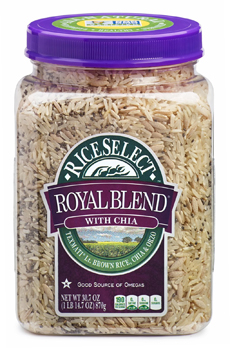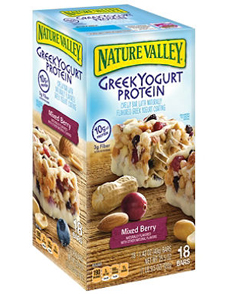What Are Functional Foods & Why Eat Functional Food
 [1] Can grains be functional foods? Yes: This rice mix adds high-nutrition chia seed to deliver more “functionality” with each bite (photo © RiceSelect). |
Functional foods are a hot topic. The first functional food we remember, long before the term existed, was Tropicana Orange Juice fortified with calcium and vitamin D. We quickly understood the benefit: Just by eating a particular food that had been fortified, we’d get a more nutrition. And maybe that would offset some of the empty carbs in all the snacks we ate. It’s so American: the promise of health without having to do more than eat. We’ve been noticing more and more functional foods coming onto the market. Some are truly enhanced, and others just hyping what’s always been there to make the product seem new and better. (Think back to the low-carb craze, when bottles of olive oil were labeled “Carb-Free!” Oils and other fats contain zero carbs. Never have, never will.) Functional foods and beverages are everyday foods enhanced (fortified) with supplemental nutrition. The goal is to provide a health benefit beyond normal satiation and nutrition. It’s not a question of the type of food. Naturally good-for-you brown rice can be functionally enhanced with flaxseed, for example; but so can chocolate chip cookies. |
|
|
The effects of the functional additive can be long term (“added calcium prevents osteoporosis”) or short-term (“the electrolytes in sports drinks help the body re-hydrate more quickly”). There are actually two kinds of functional foods. Today’s tip is about the second category, modified foods: Here are two we tried recently, and decided to keep them as part of our regular shopping list: |
||
|
Snack bars. If you snack on any type of bar, consider those that pack more protein. A Nature Valley Greek Yogurt Protein Bar contains 10g of protein; Cascadian Farm organic protein bars have 9g per serving. The USDA recommends .37 grams of protein per pound of body weight per day. This means at least 48 grams of protein for a woman who weighs 130 pounds. It’s easy to compare nutrition labels and switch when you find a product with, say, 20% more protein. Rice. RiceSelect’s Royal Blend with Chia (photo above) combines the company’s Texmati light brown rice and whole wheat orzo with chia seed, a superfood*. Packed with omega 3s, protein and fiber, the chia in one serving provides 18% of the recommended daily intake for calcium, plus manganese, phosphorus and protein. Serve it with chicken, fish or tofu and you’ve got a tasty, complete heart-healthy meal. Do a label-to-label comparison to differentiate reality from hype. In the boxed macaroni and cheese category, Horizon’s Super Mac exclaims 12g protein per serving! on the box front. Annie’s, which makes no special protein claims, has 10g per serving; Kraft has 11g. |
 [2] Grab a protein-rich snack bar instead of empty calories (photo © General Mills). |
|
|
MORE FUNCTIONAL FOODS You may already be enjoying these functional foods: Both terms mean that nutrients have been added to make the food more nutritious. But there’s a difference: *What’s a superfood? There is no government definition, but a superfood is a natural food source that is highly concentrated with a complex supply of quality nutrients. Bee pollen is the most famous superfoods, incredibly dense with thousands of phytonutrients (plant nutrients) including enzymes, bioflavonoids, phytosterols and carotenoids, free amino acids, Omega 3 essential fatty acids, naturally chelated minerals and whole vitamin complexes. The açaí berry is considered a superfood because of its extremely high level of anthocyanins (an antioxidant), vitamins A and C and omega 6 and 9 essential fatty acids, fiber and amino acids. Others include blueberries, dark chocolate, goji berries, green tea, pomegranate, soy and yumberry. According to a 2007 report from Datamonitor, “Superfood & Drinks: Consumer Attitudes to Nutrient Rich Products,” the superfood food and beverage market is expected to double by 2011 as consumers are paying more attention to diet and nutrition and increasingly seeking food and drinks with additional health-promoting benefits. |
||


